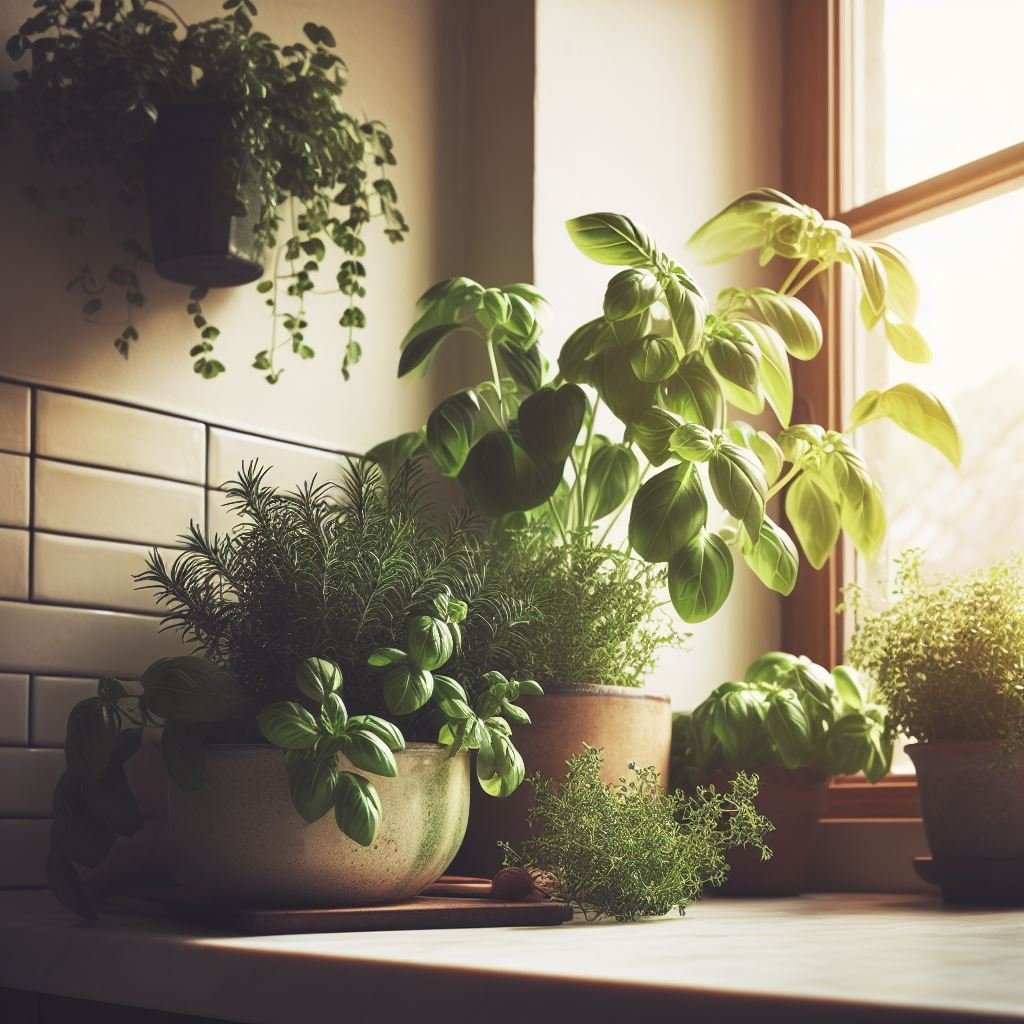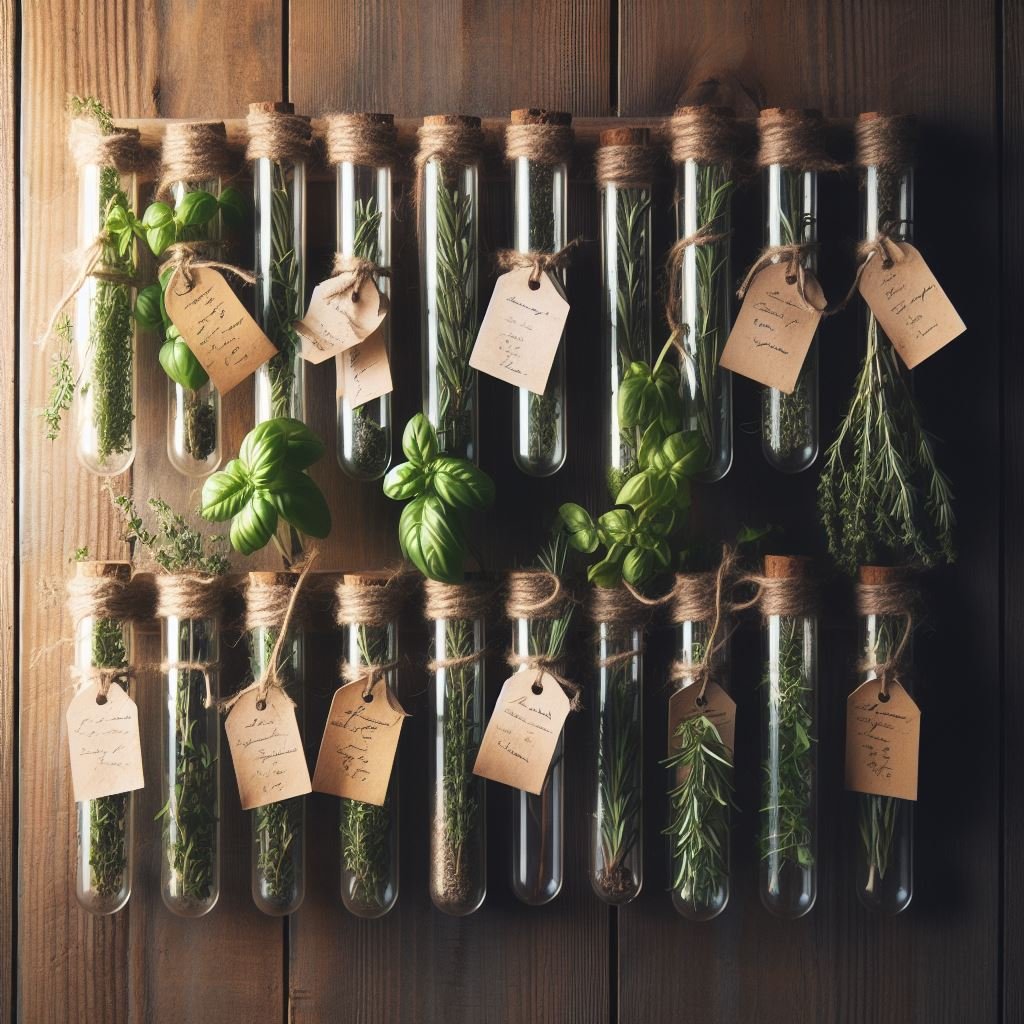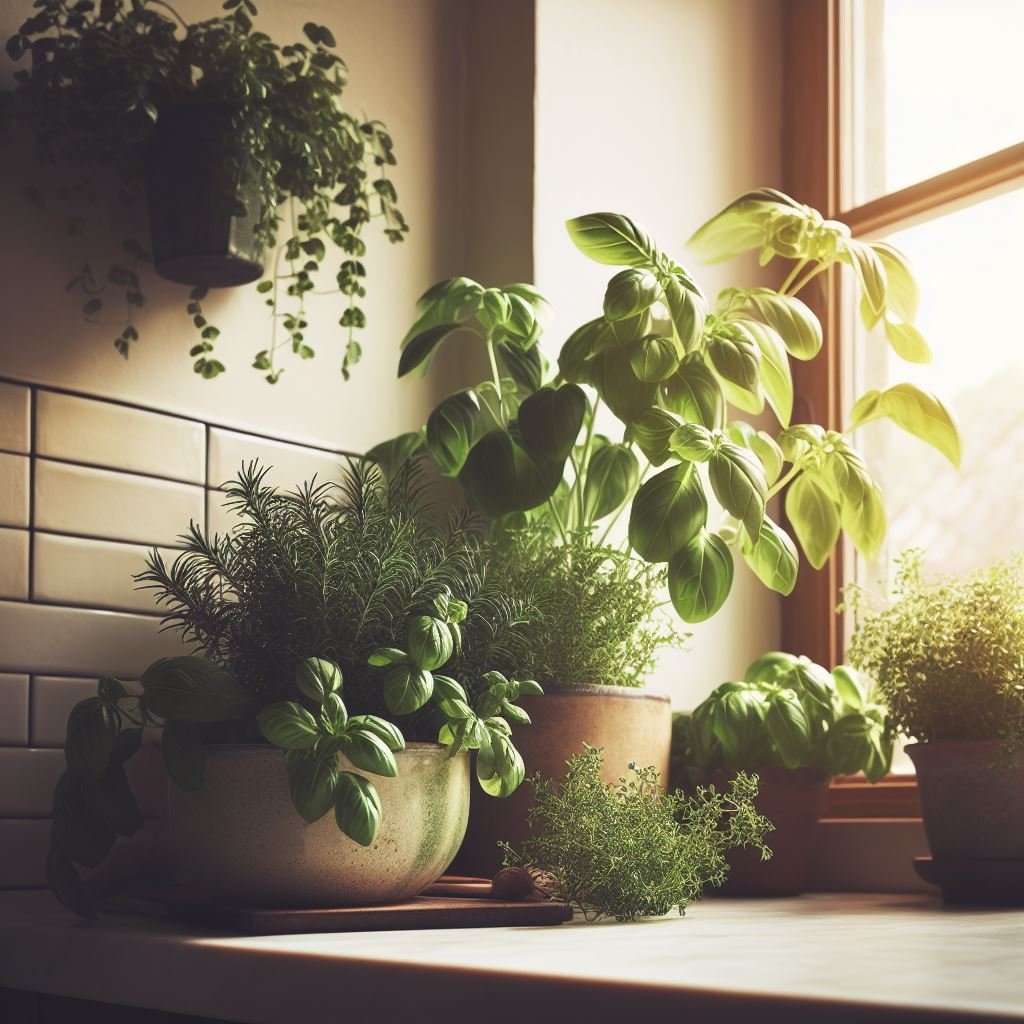Cultivating your indoor herb garden in hanging test tubes isn’t just a trend; it’s a lifestyle choice that speaks of sustainability, aesthetics, and culinary zest. It’s an innovative approach to urban farming, blending science and nature to create a fresh, green corner in your home.
This blog post will guide you through the simple steps of creating your own hanging test tube herb garden, providing a profusion of fresh herbs right at your fingertips.
Whether you’re a seasoned gardener or a first-time planter, this innovative indoor gardening method will be a game-changer, bringing a natural yet futuristic appeal to your indoor spaces. Say goodbye to wilted store-bought herbs and embrace the joy of growing your own!
Overview of Indoor Herb Gardens
Indoor herb gardening is increasingly becoming the darling of urban dwellers and culinary enthusiasts alike. But when we speak of an indoor herb garden with herbs in hanging test tubes, we are venturing into an arena that seamlessly blends aesthetics, creativity, and functionality. Imagine walking into a kitchen adorned with an array of vibrant green herbs, each suspended in its glass test tube.
Not only does it add an artistic touch to your living space, but it also provides you with a ready supply of fresh herbs at your fingertips, making your culinary adventures even more enjoyable. Creating an indoor herb garden with herbs in hanging test tubes is a relatively simple process. Begin by selecting sturdy test tubes and securing them in a hanging fixture.
The test tubes act as miniature greenhouses, providing the perfect environment for your herbs to thrive. You can choose from a wide range of herbs such as basil, rosemary, mint, or dill, depending on your culinary preferences. Each herb requires a specific amount of sunlight and water, so positioning your hanging garden near a window with plenty of natural light is key.
Regular watering, without overdoing it, will keep your herbs healthy and ready to be plucked when needed. This innovative approach to indoor herb gardening isn’t just about growing herbs in a confined space. It’s a testament to human ingenuity and our ability to adapt to changing environments.
It allows us to bring a piece of nature into our homes, transforming our living spaces into lush, green sanctuaries. An indoor herb garden with herbs in hanging test tubes is more than just a gardening trend – it’s a lifestyle choice that embraces sustainability, wellness, and the sheer joy of growing your food.

Benefits of Indoor Herb Gardens
Indoor herb gardens, specifically those with herbs in hanging test tubes, bring a unique blend of aesthetic charm and functional benefits to any space. They not only beautify your home with their greenery and creative design but also provide readily accessible fresh herbs to enhance your culinary creations.
The benefits of such indoor herb gardens extend beyond the kitchen; they purify the air, boost mental health, and offer a rewarding gardening experience.
Even in the smallest urban apartment, you can cultivate a hanging test tube herb garden and reap these wide-ranging benefits.
Popular Herbs for Indoor Gardens
Indulge in the unique charm of creating an indoor herb garden with herbs in hanging test tubes. This modern take on traditional gardening not only adds an aesthetic appeal to your interiors but also provides a constant supply of fresh herbs. This ingenious method involves growing popular herbs like basil, parsley, thyme, and rosemary in suspended test tubes.
Water and sunlight suffice their growth requirements while saving valuable floor space. The sight of these hanging green tubes can certainly bring a touch of nature to your urban dwelling, making it a delightful and functional addition to your indoor garden.
Creating a Hanging Test Tube Garden
Creating an Indoor Herb Garden with Herbs in Hanging Test Tubes Gardening, often perceived as a cumbersome outdoor activity, can be transformed into a chic and engaging indoor pastime. Imagine, if you will, a unique, indoor herb garden where your favorite herbs float in hanging test tubes. Sounds futuristic, right? But this innovative gardening idea is both practical and aesthetically pleasing.
The magic starts when you combine the charm of rustic test tubes with the freshness of herbs. Choose from a variety of herbs like rosemary, basil, or mint. These tubes, suspended from a wooden frame or metal stand, not only add a touch of greenery to your indoor space but also ensure a constant supply of fresh herbs for your culinary adventures.
Creating an indoor herb garden with herbs in hanging test tubes is a simple yet exciting process. It commences with choosing the right herbs for your indoor environment, considering factors such as light, space, and humidity. Next, you need to secure your test tubes in a holder of your choice.
Fill each tube with water and place your herb cuttings inside. Voila! Your indoor hanging test tube garden is ready to thrive. This ingenious concept of an indoor herb garden with herbs in hanging test tubes not only serves as a functional element in your kitchen but also as a conversation starter.
It’s a delightful blend of science and nature right in your living space. So why wait? Get started on creating your own little indoor Eden.

Materials Needed
Creating an indoor herb garden with herbs in hanging test tubes is an innovative and stylish way to cultivate your favorite herbs. The materials needed for this unique project include glass test tubes, sturdy string or wire for hanging, potting mix, and of course, your chosen herb seeds. A bonus is that this creative gardening approach not only provides you with fresh herbs for cooking, but it also adds an aesthetic element to your home decor.
So, grab these materials, embrace your green thumb, and let’s engage in some fun, scientific gardening!
Step-by-Step Assembly Instructions
In this blog section, we’ll take you through a step-by-step guide to create your very own indoor herb garden using hanging test tubes. This inventive method not only adds a unique aesthetic to your home but also ensures your favorite herbs are always within arm’s reach. With our easy instructions, you’ll have a charming, functional, and space-saving herb garden in no time.
So, get ready to roll up your sleeves and let your inner botanist shine as we delve into this fun and innovative gardening project.
Hanging and Arrangement Tips
Creating an indoor herb garden with herbs in hanging test tubes not only serves a culinary purpose but also adds a touch of creativity and aesthetic appeal to your space. Choosing the right herbs, having adequate sunlight, and maintaining the right temperature are some key aspects of this setup. Additionally, the arrangement of these hanging test tubes can dramatically enhance the overall look.
A staggered, spiraling pattern can create a captivating visual effect. Alternatively, a linear, minimalist arrangement can seamlessly blend with modern interiors. Regardless of your style preference, this innovative indoor garden can bring a breath of fresh air into your home.
Caring for Your Test Tube Herb Garden
Cultivating an indoor herb garden with herbs in hanging test tubes is an innovative and stylish way to bring a touch of nature into your home. This chic approach not only adds a unique aesthetic element to your interior decor but also provides a constant supply of fresh herbs for your culinary endeavors. However, just like any other indoor plant, these test tube herbs also require a certain degree of care and attention.
The success of your indoor herb garden in hanging test tubes lies in understanding the basic requirements of the herb species you choose to grow. Each herb has its specific needs in terms of light, temperature, water, and nutrient levels. For instance, herbs such as basil, rosemary, and oregano thrive in bright light and warm temperatures, while parsley and chives prefer cooler conditions.
Watering these herbs can be a bit tricky given the confined space of a test tube. Overwatering can easily lead to root rot, while underwatering can cause the herbs to wilt and die. Therefore, it’s crucial to strike a balance; a good rule of thumb is to water sparingly but regularly to keep the soil slightly moist.
Feeding your test tube herbs with a diluted liquid fertilizer also promotes healthy growth. However, keep in mind that less is often more when it comes to fertilizing; an overdose can harm the plants. Lastly, remember to prune your herbs regularly.
This not only encourages bushier growth but also ensures a continuous supply of fresh leaves for your kitchen. In conclusion, maintaining an indoor herb garden with herbs in hanging test tubes can be a rewarding experience. As long as you provide the right care and conditions, these miniature gardens can flourish, enhancing your home’s aesthetics and your culinary creations simultaneously.

Watering and Sunlight Requirements
Maintaining an indoor herb garden with herbs in hanging test tubes is a delightful blend of science and nature. The secret to their vibrant growth lies predominantly in two factors: watering and sunlight requirements. While overwatering can drown the herbs, underwatering can cause them to wither; thus, maintaining a balanced moisture level is crucial.
Sunlight, on the other hand, is the lifeblood of these green wonders. Your indoor herb garden craves a generous dose of indirect sunlight, so placing your hanging test tubes near a window that invites ample morning light can be the perfect spot. In essence, the harmony of adequate watering and sunlight can turn your indoor herb garden into a thriving green haven.
Pruning and Harvesting Herbs
Cultivating an indoor herb garden with herbs in hanging test tubes can be a delightful and innovative way to bring a touch of nature into your home. However, to ensure a continuous supply of fresh herbs, proper pruning and harvesting techniques are paramount. Pruning not only encourages new growth but also maintains the plant’s health, while the timing and method of harvesting can significantly affect the herb’s flavor and potency.
So, roll up your sleeves and let’s dive into the fascinating world of indoor herb gardening – a realm where science meets nature, and culinary dreams come alive.
Troubleshooting Common Issues
Troubleshooting Common Issues in Your Indoor Herb Garden with Herbs in Hanging Test Tubes Creating an indoor herb garden with herbs in hanging test tubes is an innovative way to imbue your space with greenery while ensuring a fresh supply of herbs for your culinary adventures. However, like all gardening endeavors, it may come with its own set of challenges. Fear not, for we are here to help you troubleshoot the most common issues you may encounter.
One of the most common problems is inadequate sunlight. Herbs require a good amount of sunlight to thrive; hence, it is essential to place your hanging test tubes in a location that receives ample sunlight. If you are struggling to find such a spot, consider using grow lights to supplement the natural light.
Another common issue is improper watering. It’s easy to overwater your herbs in the enthusiasm of maintaining your new indoor garden. However, excessive moisture can lead to root rot, a fatal condition for your plants.
To prevent this, make sure only to water your herbs when the top layer of the soil feels dry to the touch. Lastly, the lack of proper nutrients can also hinder the growth of your indoor herb garden. Regularly fertilizing your herbs with a balanced organic fertilizer can effectively combat this issue.
Remember, every garden, whether indoor or outdoor, has its quirks and challenges. With a little patience, research, and love, your indoor herb garden with herbs in hanging test tubes will be a flourishing, aromatic spectacle in no time.
Frequently Asked Questions (FAQs)
What are the benefits of an indoor herb garden with herbs in hanging test tubes?
An indoor herb garden with herbs in hanging test tubes is a great way to grow fresh herbs year-round. It’s a space-saving solution and it adds a decorative element to any room. Plus, it allows for easy access when cooking.
What types of herbs can I grow in hanging test tubes for my indoor garden?
Most herbs can be grown in hanging test tubes. Some popular choices include basil, rosemary, parsley, thyme, oregano, and mint. Make sure to research each herb’s specific needs, as some may require more sunlight or water than others.
How do I care for my indoor herb garden with herbs in hanging test tubes?
Care for an indoor herb garden in hanging test tubes involves regular watering, ensuring they receive adequate sunlight and periodic feeding with balanced plant food. It’s also important to prune your herbs regularly to encourage new growth.
How much light does an indoor herb garden with herbs in hanging test tubes need? How much light does an indoor herb garden with herbs in hanging test tubes need?
Most herbs need about 6-8 hours of sunlight per day. If you don’t have a spot that gets enough natural light, you can supplement with a grow light.
Can an indoor herb garden with herbs in hanging test tubes be set up in any room?
Yes, an indoor herb garden with herbs in hanging test tubes can be set up in any room, as long as it gets enough light and is in a place where the temperature is consistent. However, it’s typically recommended to set it up in or near the kitchen for easy access while cooking.
What are the best materials to use for hanging test tubes in an indoor herb garden?
Glass test tubes are a popular choice for hanging indoor herb gardens due to their durability and transparency. They allow you to see the roots and water level easily. The rack or holder for the test tubes can be made of any sturdy material like wood or metal.
Conclusion
The indoor herb garden with herbs in hanging test tubes is a fusion of botany and chemistry, creating a unique blend of science and nature. It’s not just a garden; and it’s a laboratory of flavors. It’s a great way to grow fresh herbs indoors in a visually pleasing way while also serving as an interesting conversation starter.
So, for those who love to combine their culinary skills with a dash of scientific flair, this setup could be the perfect ingredient. Remember, you don’t need a green thumb here, just a little bit of scientific curiosity!
